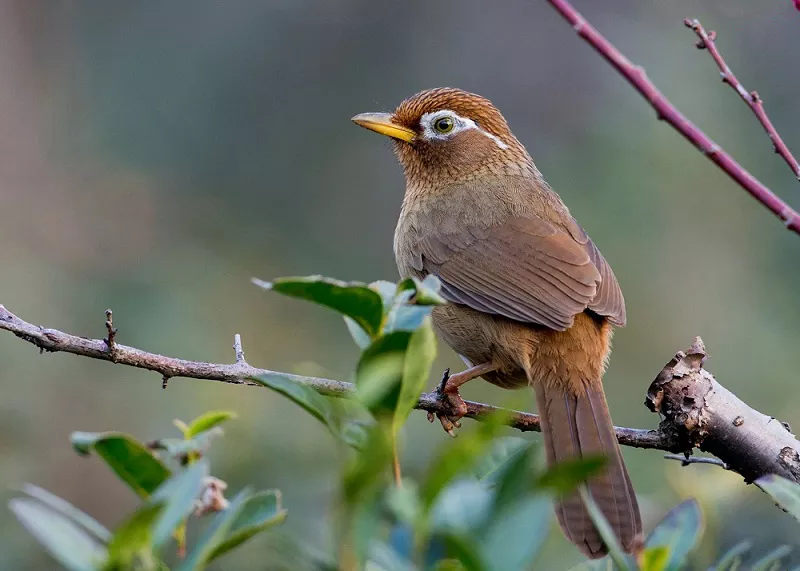Chinese huamei male and female have similar plumage color. The forehead is brown, the top of the head to the upper back is brown, and there are broad dark brown longitudinal stripes from the forehead to the upper back. The eye circles are white, and the white upper edge extends back into a narrow line to the side of the neck, which looks like eyebrow lines, so it is called Chinese huamei.
The side of the head includes the eyes and ear feathers dark brown, the rest of the upper body includes the wing coverts brown olive brown, the flight feathers on both wings are dark brown, the outer flight feathers, the outer feathers are decorated with brown, and the base of the inner feathers also has a broad brown edge.
The inner flight feathers are brown olive brown, the tail feathers are thick brown or dark brown, with multiple inconspicuous dark brown horizontal spots, and the tail end is darker brown. The chin, throat, upper chest and chest side are brownish yellow mixed with dark brown longitudinal stripes, the rest of the lower body is also brownish yellow, the two flanks are darker without vertical stripes, the middle part of the abdomen is dirty gray, the perianal area is brown, and the underwing coverts are brownish yellow.
The Chinese huamei has a slender body, slightly in the shape of a shuttle with two pointed ends and a large middle, with a streamlined outline. Generally, the upper body feathers are olive-colored, the lower abdomen feathers are greenish-brown or yellowish-brown, and a small part of the feathers in the center of the lower abdomen is off-white without markings; the feathers on the head, chest, neck and tail feathers are darker, with black stripes or horizontal stripes . Its eye circles are white, and there is a white eyebrow on each side of the eye, extending from front to back symmetrically, and most of them are crescent-shaped, which is very beautiful, so it gets this name.
There is a horny beak (beak) at the front of the head, which is the organ for Chinese huamei to peck, comb feathers, fight and sing. Generally, the mouth is about 20-25 mm long, and the upper mouth is slightly longer than the lower mouth. The cutin of the upper lip is brownish-black, with a larger area, and the cutin of the lower lip is brownish-black, but the color is lighter than that of the upper lip, and the area is also smaller. There are nostrils on the back and upper sides of the upper lip. There is a long black mustache (commonly known as beard) growing near the forehead.
Its two eyelids are round. The two eyes produce various colorful “eye sand” due to the difference in the visual pigments in the eyes. There is a layer of nictitating membrane on the outside of the eyeball, which is usually open and closed during flight to protect the eyeball. There is an eye ring on the outermost layer of the eyeball, which also plays a role in protecting the eyeball. Behind the two eyes, there are sunken earholes the size of soybeans, surrounded by ear feathers, which help to collect sound waves.
The wings of Chinese huamei are longer, and the flight feathers are about 75 mm long from the front breast cover to the back. After the wings are spread out, the left and right sides are 90-110 mm wide. Chinese huamei lacks glands, and the only skin gland is called tail fat gland, which is born at the root of tail feathers and can secrete oil to protect feathers from deformation and waterproof. The lower part of the body is the claws, which are generally light yellowish brown, and the height of the shins is about 40 mm.
Juvenile birds in July have light brown upper body without vertical stripes, and no horizontal spots on the tail, and brownish white underparts with no vertical or horizontal stripes. In September, the young bird is similar to the adult bird, but the feather color is slightly darker, and there are dark brown vertical stripes from the top of the head to the upper back, throat to chest.
The iris is orange-yellow or yellow, the upper mouth is orange, the lower mouth is olive-yellow, and the tarsus and toes are yellowish brown or light.


 Facebook
Facebook  Instagram
Instagram  Youtube
Youtube 